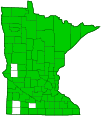Allegheny monkeyflower
(Mimulus ringens var. ringens)
Conservation • Wetland • Description • Habitat • Ecology • Use • Distribution • Taxonomy
Description |
||
Allegheny monkeyflower is an erect, perennial forb that rises on one or more stems from a stout underground stem (rhizome) and fibrous roots. It may be 12″ to 52″ tall but in Minnesota is usually no more than 40″ in height. The stems are erect, sharply four-angled, light green, hairless, usually branched, and sometimes very narrowly winged. The leaves are opposite, lance-shaped to narrowly oblong, and pinnately veined. They are stalkless and often partially surround (clasp) the stem. The larger leaves are 2″ to 4¾″ long, and ⅜″to 1⅜″wide, 3 to 7 times as long as wide, becoming progressively smaller as they ascend the stem. They are rounded or tapered at the base and taper to a sharp point at the tip with straight or concave sides along the tip. The upper and lower surfaces are light to medium green and hairless. The margins are toothed with blunt, forward pointing teeth. The inflorescence is a solitary flower rising on a long stalk from each upper leaf axil. The flower stalks are ⅝″ to 1½″ long and have no additional leaves or bracts. As the fruit develops the stalk elongates, eventually becoming ¾″ to 2⅜″ long. The flowers are ¾″ to 1½″ long. There are 5 sepals, 5 petals, 4 stamens, and 1 style. The sepals are united at the base into a narrowly funnel-shaped, ⅜″ to ⅝″ long calyx tube, then separated at the tip into 5 triangular or broadly triangular, ⅛″ to 5 ⁄16″ long lobes. The lobes are much shorter than the tube and are not hooked at the tip. The midrib of each sepal often extends beyond the lobe as a short, stiff awn. When the fruit develops the calyx enlarges slightly but does not become inflated. The petals are light lavender-blue to purplish-blue. They are fused at the base into a corolla tube then separated into a 2-lobed upper lip and a 3-lobed lower lip. The upper lip is much smaller and narrower than the lower. It is erect and strongly bent upward. The lower lip is bent downward and has a pale yellow area toward the base with red or brownish-red spots. The base of the lower lip is swollen more or less closing the throat. Neither the stamens nor the style protrude beyond the corolla tube. The fruit is a hairless, ⅜″ to ½″ long, egg-shaped to narrowly egg-shaped capsule with numerous seeds. |
||
Height |
||
12″ to 40″ |
||
Flower Color |
||
Light lavender-blue to purplish-blue |
||
Similar Species |
||
| James’ monkeyflower (Mimulus glabratus var. jamesii) stems creep along the ground with their tips ascending. The leaves are stalked, circular to oval or kidney-shaped, and have palmate venation. The flowers are yellow. | ||
Habitat |
||
Wet to moist. Meadows, swamps, fens, open marshy areas, streambanks, riverbanks, springs, and roadside ditches. Full or partial sun. |
||
Ecology |
||
Flowering |
||
June to August |
||
Pests and Diseases |
||
|
||
Use |
||
|
||
Distribution |
||||
|
Sources |
|||
| 2/8/2023 | ||||
Nativity |
||||
Native |
||||
Occurrence |
||||
Common and widespread |
||||
Taxonomy |
|||
| Kingdom | Plantae (Plants) | ||
| Division | Tracheophyta (Vascular Plants) | ||
| Subdivision | Spermatophytina (Seed Plants) | ||
| Class | Magnoliopsida (Dicots) | ||
Order |
Lamiales (Mints, Plantains, Olives, and Allies) | ||
Family |
Phrymaceae (lopseed) | ||
| Genus | Mimulus (monkeyflowers) | ||
| Species | Mimulus ringens (Allegheny monkeyflower) | ||
Family Genus |
|||
Synonyms |
|||
Mimulus minthodes Mimulus pallidus Mimulus ringens var. congesta Mimulus ringens var. minthodes |
|||
Common Names |
|||
Allegheny monkeyflower Allegheny monkey-flower square-stem monkeyflower |
|||
The genus name Mimulus, from the Greek mimos meaning “imitator”, and the common name “monkeyflower”, both refer to red markings on the corolla of some of the yellow species which are said to resemble a monkey’s face. |
|||
Glossary
Axil
The upper angle where a branch, stem, leaf stalk, or vein diverges.
Bract
Modified leaf at the base of a flower stalk, flower cluster, or inflorescence.
Calyx
The group of outer floral leaves (sepals) below the petals, occasionally forming a tube.
Clasping
Describing a leaf that wholly or partly surrounds the stem but does not fuse at the base.
Corolla
A collective name for all of the petals of a flower.
Pinnately veined
With the veins arranged like the vanes of a feather; a single prominent midvein extending from the base to the tip and lateral veins originating from several points on each side.
Rhizome
A horizontal, usually underground stem. It serves as a reproductive structure, producing roots below and shoots above at the nodes.
Wing
A thin, flat, membranous, usually transparent appendage on the margin of a structure.
Visitor Photos |
|||||
Share your photo of this plant. |
|||||
| This button not working for you? Simply email us at info@MinnesotaSeasons.com. Attach one or more photos and, if you like, a caption. |
|||||
Bill Reynolds |
|||||
Found this flower blooming along the bank of the Red Lake River in Red Lake County at the Old Treaty Crossing, Huot MN. |
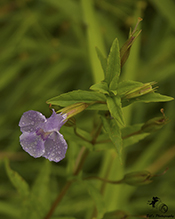 |
||||
MinnesotaSeasons.com Photos |
|||||
Plant |
|||||
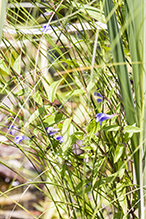 |
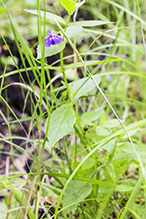 |
||||
Flower |
|||||
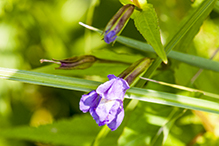 |
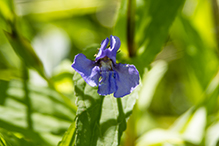 |
||||

Slideshows |
||
| Mimulus ringens (Allegheney Monkey-Flower) Allen Chartier |
||

|
||
| Mimulus ringens Dena Grossenbacher |
||

|
||

Visitor Videos |
|||
Share your video of this plant. |
|||
| This button not working for you? Simply email us at info@MinnesotaSeasons.com. Attach a video, a YouTube link, or a cloud storage link. |
|||
Other Videos |
|||

Visitor Sightings |
|||||
Report a sighting of this plant. |
|||||
| This button not working for you? Simply email us at info@MinnesotaSeasons.com. Be sure to include a location. |
|||||
| Bill Reynolds 8/26/2017 |
Location: Huot MN Found this flower blooming along the bank of the Red Lake River in Red Lake County at the Old Treaty Crossing, Huot MN. |
 |
|||
MinnesotaSeasons.com Sightings |
|||||

|
Created: Last Updated: © MinnesotaSeasons.com. All rights reserved. |
